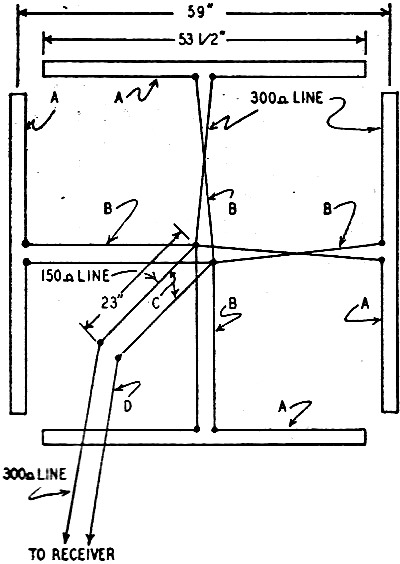All-Way FM Antenna
|
|
Have you heard of an Alford Loop antenna? I hadn't until reading this article. It is a four-sided structure consisting of identical folded ½-wave dipoles on each side, with a common feed. Opposing sides have their elements 180 degrees out of phase with respect to each other. The intention is to provide nearly omnidirectional FM radio reception across the entire 88-108 MHz band. A little research on the Alford Loop reveals that Mr. Andrew Alford developed this configuration to enable simultaneous, co-located transmissions of FM radio stations. In that case the four antennas are individually fed by transmitters on different frequencies. Alford is credited with inventing antenna systems for the VFH Omnidirectional Range (VOR) and Instrument Landing System (ILS) navigational aids. All-Way FM Antenna By Julian T. Dixon This antenna has been found to give optimum reception of each of several FM broadcast stations located in different directions from the receiver. Its response is substantially independent of direction. Its gain is the same as that of a properly oriented dipole. It is an Alford loop comprising 4 folded-dipole elements arranged in a square, half-wave length on a side. Transmitting antennas of this basic type have been described previously and are in use at many FM broadcast stations.
Since the B sections are effectively in parallel at their junction, the impedance there is one-fourth of 300 ohms, or 75 ohms. The standard receiver input impedance is 300 ohms; consequently a quarter-wave length section C of 150-ohm line is used to step up the 75-ohm impedance at the junction to the 300-ohm impedance of the line D to the receiver. The D section may be of any length sufficient to reach the receiver. It was found that an antenna constructed according to the dimensions shown worked well over the entire FM broadcast band, 88 to 108 megacycles, although it was cut specifically for 100 megacycles. S-meter readings indicated an improvement of as much as 17 decibels over the dipole previously used, for signals from stations which were not in the broadside direction of the dipole. For signals arriving from the dipole broadside direction, the loop gave an equal input to the receiver. Less fading due to reflection of the signal from airplanes overhead was noted with this loop, as compared with the dipole. This improvement is attributed partly to the fact that the loop has some directivity in the vertical plane, giving maximum response at zero degrees elevation and decreasing to zero response at 90 degrees. Signals reflected from airplanes above the horizon are thus rejected to some extent. Signals arriving from the dipole minimum direction had been especially subject to flutter fading due to the reflected signal being received from airplanes which were broadside to the dipole. This condition was remedied by the omnidirectional response of the loop in addition to its vertical plane directivity. The loop must be mounted in the horizontal plane and the C and D sections should drop away vertically from the junction of the B sections for a distance, preferably, of 5 feet or more. The dipole elements may be suspended conveniently from the ends of 2 light diagonal wooden supports. For an attic installation, four nails can be driven into the rafters as supports. Care should be taken to connect the components exactly as shown. The 180-degree twist in 2 of the B sections as shown provides the required 180-degree phase relationship of opposite dipoles while maintaining an in-phase condition around the perimeter of the loop. The dimensions of the antenna components in wave lengths are given below for the convenience of those who may wish to construct similar antennas for use on other frequency bands. Section Length A 0.45 wave length B 0.25 wave length (or more) C 0.193 wave length (see note) D any length Note: Length of C section is 0.25 wave length multiplied by 0.77, the velocity constant of the 150-ohm line. A Teleran experimental installation is being made near Washington, D. C., for operational tests of the new navigational aid. Teleran is a name coined from the words Television-Radar-Air-Navigation. The unique system of air navigation and traffic control combines ground search-radar and television to furnish the pilot a constant "aerial roadmap" on a screen on his instrument panel. This composite pictorial presentation of route, terrain, traffic, and weather data clearly identifies all mountains and other obstacles to aviation, and is expected eventually to make all-weather flying a practical reality.
Posted May 21, 2022 |
|

 The antenna components are made of readily available
and inexpensive sections of twin-lead transmission line. The 4 folded-dipole elements
A are made of 300-ohm line and have a terminal impedance of about 300 ohms. The
terminals of the dipoles are connected to a junction in the center of the antenna
through equal lengths B of 300-ohm line. The B sections may be made long enough
to provide sufficient slack to prevent pulling the dipoles out of shape.
The antenna components are made of readily available
and inexpensive sections of twin-lead transmission line. The 4 folded-dipole elements
A are made of 300-ohm line and have a terminal impedance of about 300 ohms. The
terminals of the dipoles are connected to a junction in the center of the antenna
through equal lengths B of 300-ohm line. The B sections may be made long enough
to provide sufficient slack to prevent pulling the dipoles out of shape.